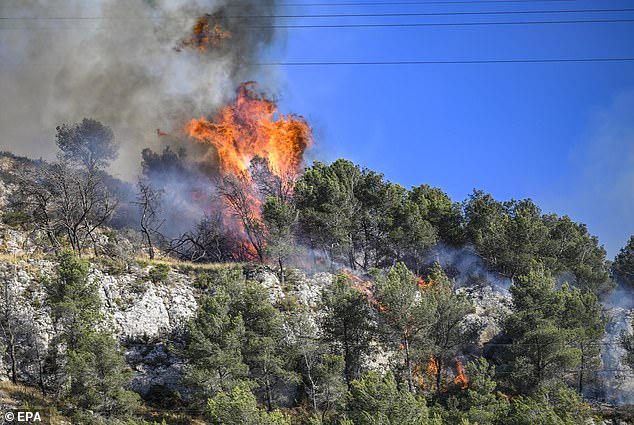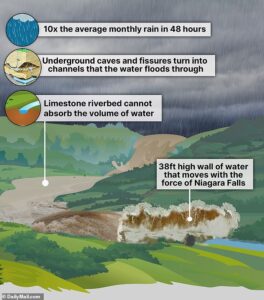
As many as 2,300 people died of heat-related causes across 12 European cities during the recent two-week heatwave, bleak new research has found.
British scientists studying the 10 days to July 2, and looking at cities including London, Madrid, Barcelona and Milan, found climate change had increased temperatures by as much as 4 degrees Celsius, linked to 1,500 of the deaths
Last month was the planet’s third-hottest June on record, behind 2024 and 2023, while Western Europe saw its warmest June since records began, the EU’s Copernicus Climate Change Service said today.
Maximum feels-like temperatures north of Lisbon hit 48C, about 7C above average and associated with ‘extreme heat stress’, it said.
Portugal alone has recorded 284 deaths during the ongoing heatwave, with highs of 40C expected to persist until the middle of the week. The Foreign Office this week issued a warning to Brits that the country faces heightened risk of wildfires.
More than 100 people were injured and hundreds more evacuated on Tuesday as wildfires broke out on the outskirts of Marseille. Around 800 firefighters were called in, working through the night to try to control the blaze as strong winds helped it spread at a rate of 0.75 miles every minute at its peak.
Marseille’s mayor Benoît Payan said emergency services were ‘waging guerilla warfare,’ against the fire, ‘hoses in hand’, in a desperate bid to stop the spread.
In neighbouring Spain, more than 18,000 people in Tarragona were ordered to stay indoors on Tuesday as a wildfire raged out of control, destroying more than 3,300 hectares of vegetation before the lockdown was lifted today.
Spain recently sweltered through a heatwave that parched the land, while national weather agency AEMET said last month that it was the country’s hottest June on record. Around 21,000 hectares of land have burned so far this year.

A wildfire rapidly expands due to strong winds near the city of Marseille, France, on Tuesday

Smoke billowing from a forest fire near Pauls, next to Tarragona, Spain on Tuesday

People sit in the shade near the Acropolis, with 40C expected in Greece on Wednesday
Two people died in a wildfire on July 1 in the region of Catalonia, where Tarragona is located.
Heatwaves are particularly dangerous for the elderly, the sick, young children, outdoor workers, and anyone exposed to high temperatures for prolonged periods without relief.
Scientists at Imperial College London and the London School of Hygiene and Tropical Medicine found that in the 10 days to July 2, there may have been some 2,300 heat-related deaths in the cities studied.
No official death toll is yet available, and the study has not been peer reviewed.
Of the 2,300 people estimated to have died during this period, 1,500 deaths were linked to climate change, which made the heatwave more severe.
The researchers used established epidemiological models and historical mortality data to estimate the death toll, which reflects deaths where heat was the underlying reason for mortality, including if exposure exacerbated pre-existing health conditions.
‘An increase in heatwave temperature of just two or four degrees can mean the difference between life and death for thousands of people,’ said Garyfallos Konstantinoudis, a lecturer at Imperial College London.
‘This is why heatwaves are known as silent killers. Most heat-related deaths occur in homes and hospitals out of public view and are rarely reported,’ he told reporters.

A wildfire rapidly expands due to strong winds near the city of Marseille, France, on Tuesday
Globally, last month was the third warmest June on record. The hottest June was in 2024 and the second hottest was in 2023, Copernicus said.
Several countries recorded surface temperatures above 40 degrees Celsius (104 Fahrenheit), with heat of up to 46C (114.8F) in Spain and Portugal, the Copernicus Climate Change Service (C3S) said.
Dangerous temperatures have stretched into July, with tourist hotspots pressed to provide relief in affected regions as firefighters stand by to deal with future wildfires
The Acropolis in Athens today limited its operating hours for a second straight day because of heatwave conditions. The Greek ministry of culture cited ‘the safety of workers and visitors, owing to high temperatures.’
In France, the wildfire that reached the northwestern outskirts of Marseille lost intensity on Wednesday, but firefighters still continued to battle the blaze into today and warned that it could flare up again.
Officials told residents they were no longer in lockdown, though some who were evacuated were likely to find their homes in ashes. Ten houses were completely destroyed and dozens damaged, they said, though no fatalities were reported.
Likewise in Spain, Wednesday saw the lifting of a lockdown for thousands of villagers in northeastern Catalonia. Firefighters were still trying to bring the fire under control after three days.
Catalonia’s fire service said it had ‘stabilised’ the blaze but continued to work with ground units, helicopters and aeroplanes on several hotspots, including cliffs and areas that are hard to access.
The blaze that started on Monday has burned more than 3,300 hectares (8,154 acres) in Tarragona province, with the protected Els Ports natural park making up around one-third of the affected area, Catalan countryside rangers said.
In the Balkans, Greece was bracing for an extreme wildfire threat on Wednesday.
The Ministry for Climate Crisis and Civil Protection said Attica (excluding Kythira), Central Greece (parts of Boeotia and Phthiotis), the Peloponnese (Corinth) and Thessaly (Magnesia region, excluding the Sporades Islands) were at the highest level of risk.

A palm tree burns at Split Airport, in Croatia, after being struck by lightning during a major storm followed by heavy rain, hail and strong winds

General view of the flames of the fire engulfing the vegetation of the hills of Marseille

A plane drops water on a wildfire that rapidly expands due to strong winds near the city of Marseille

A woman watches activities on the beach on a warm and sunny summer day on the Promenade des Anglais in Nice, France, July 9

Large flames leap from the trees as a wildfire burns through forested areas in Tarragona

Tourists take cover from the sun outside the entrance of the Acropolis hill during a heat wave in Athens, Wednesday, July 9, 2025
Bulgaria also saw two wildfires break out on Tuesday as temperatures reached a record 42C.
The city of Veliko Tarnovo and the town of Ihtiman, both in land, saw huge fires break out, prompting large-scale responses from emergency services.
And North Macedonia declared a 30-day State of Crisis on Wednesday due to the rise in reports of wildfires.
The move will ready army, police, fire services and other relevant agencies to rapidly mobilise in case of future fires.
Storms brought heavy rain to Croatia. A tree caught on fire near Split Airport when struck by lightning this week.
Poland also readied troops for bad weather. According to Expressen, 7,000 troops have been put on alert to assist in evacuation efforts as the country braces for torrential rains over the next two days.
Authorities say the weather could cause flooding, power outages and devastation.
Temperatures across the UK, meanwhile, are set to rise ‘day by day’ through the rest of the week with predicted highs ‘in the low 30s’, the Met Office said.
The forecaster said highs of 26C to 28C can be expected in some of the hotter spots across central parts of the UK from Wednesday.
By the end of the week, even the far north and west can expect hot temperatures ‘in the high 20s and low 30s’, a Met Office meteorologist said.
It comes after a yellow heat health alert was issued for the southern half of England on Tuesday by the UK Health Security Agency (UKHSA).






